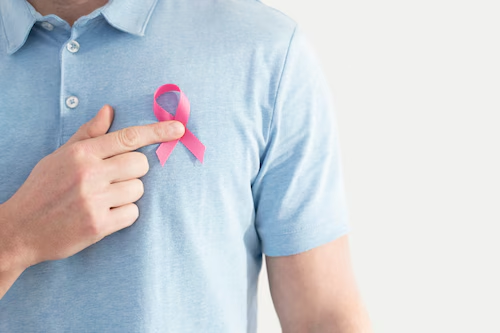Male breast cancer is a rare but significant health concern that can affect men, albeit far less commonly than women. While breast cancer is predominantly a female disease, men can develop cancer in the breast tissue, particularly in the small amount of tissue located behind the nipples.
Typically, this condition affects men around the age of 60 or older. Because it is less common, male breast cancer is often diagnosed at a later stage, complicating treatment efforts.
Causes of Male Breast Cancer
Understanding the causes of male breast cancer is crucial in recognizing the factors that may increase the risk. While the exact origins of this disease are not completely understood, several key risk factors have been identified:
1. Age: Like many cancers, the likelihood of developing breast cancer rises with age. Male breast cancer is particularly more common in men over the age of 60.
2. Genetic Mutations: Inherited mutations in genes, especially BRCA1 and BRCA2, significantly elevate the risk of breast cancer in men. These genes are often discussed in the context of breast cancer in women but are equally important for men, as they can lead to a higher susceptibility to various cancers.
3. Family History: Men with close relatives (male or female) who have experienced breast cancer are at a higher risk. This familial link suggests that genetics play a crucial role in the development of the disease.
4. Radiation Exposure: Prior exposure to radiation, especially in the chest area, has been linked to an increased risk of developing breast cancer later in life. This may include radiation therapy for other cancers.
5. Hormonal Imbalances: Certain conditions that lead to higher levels of estrogen can increase the risk of male breast cancer. For instance, Klinefelter syndrome is a genetic disorder that results in the presence of an extra X chromosome, leading to higher estrogen levels. Liver diseases, such as cirrhosis, can also affect hormone levels and elevate cancer risk.
6. Body Weight: Excess fat tissue in men can lead to increased estrogen production, which is associated with a heightened risk of developing hormone-related cancers, including breast cancer.
7. Testicular Issues: Conditions such as undescended testicles or injuries to the testicles may contribute to a higher likelihood of developing breast cancer in men.
8. Alcohol Consumption: Heavy alcohol use can disrupt hormonal balance in the body, further increasing the risk of developing breast cancer.
Recognizing the Signs
Detecting male breast cancer early is crucial for effective treatment. However, the early signs are often subtle and can easily be overlooked. Here are some common symptoms to watch for:
1. Painless Lump: The most prevalent sign of male breast cancer is the presence of a painless lump or thickening in the breast tissue, typically located near the nipple. If you notice any new lump, it is essential to consult a healthcare professional.
2. Nipple Changes: Changes in the nipple may also occur. This can include nipple retraction (where the nipple turns inward), redness, scaling, or unusual discharge, which may sometimes be bloody.
3. Skin Changes: The skin surrounding the breast may exhibit various changes, such as dimpling, redness, or developing a rash or sores. These signs can indicate underlying issues that require medical attention.
4. Swollen Lymph Nodes: Swelling in the lymph nodes under the arm or near the collarbone could signal that the cancer has spread. This symptom should not be ignored, as it may indicate a more advanced stage of the disease.
Prevention Tips
While male breast cancer cannot be entirely prevented, several proactive measures can help reduce the risk. Here are some practical tips:
1. Maintain a Healthy Weight: Reducing excess body fat can lower estrogen levels in the body, decreasing the risk of hormone-related cancers. Engaging in regular physical activity and following a balanced diet can significantly contribute to overall health.
2. Limit Alcohol Intake: Keeping alcohol consumption within moderation is vital for maintaining hormonal balance. Reducing alcohol intake may also help lower cancer risk.
3. Genetic Counseling: Men with a family history of breast cancer or known BRCA gene mutations should consider seeking genetic counseling. This professional guidance can help determine the need for screening and early detection measures.
4. Regular Self-Exams: Men, especially those with risk factors, should perform regular self-exams to check for any unusual lumps or changes in the breast area. If anything seems unusual, consulting a healthcare professional is crucial for timely evaluation.
5. Avoid Unnecessary Hormonal Treatments: Limiting the use of estrogen-based treatments, unless prescribed by a healthcare provider, can help reduce potential risks associated with hormone-related cancers.
6. Stay Informed: Awareness is key. Educating oneself about male breast cancer, its risk factors, and the importance of early detection can empower individuals to take proactive steps in their health journey.
The Bottom Line
While male breast cancer is a rare condition, it is essential to recognize that it can have serious implications for those affected. Awareness of the risk factors, recognizing early symptoms, and understanding treatment options are crucial for effective management of the disease.
Regular self-examinations, maintaining a healthy lifestyle, and consulting healthcare professionals about any concerning changes are vital for reducing risk and improving outcomes in cases of male breast cancer.





